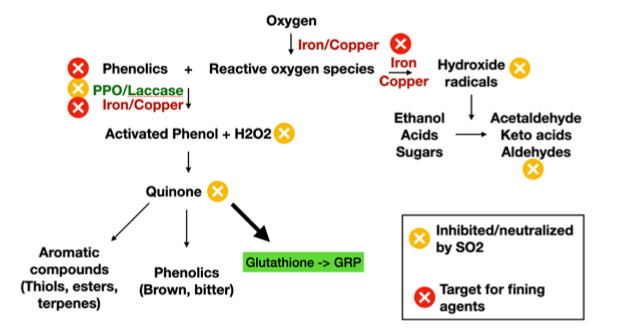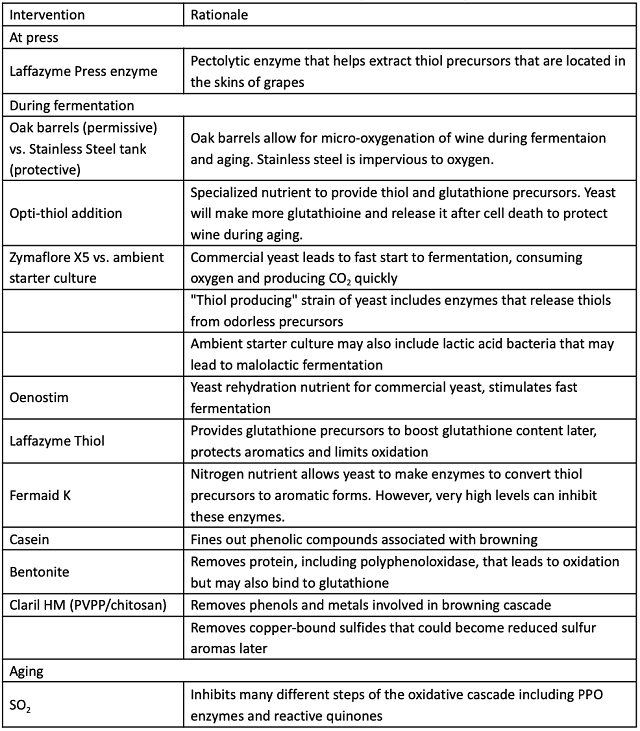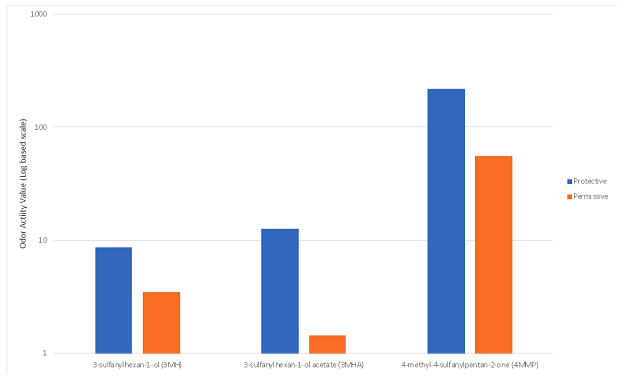Winemaking interventions drive style in Sauvignon Blanc (2021)
Matthieu Finot
King Family Vineyard
Summary
Like many aromatic white wines, Sauvignon Blanc aroma and flavor profile is a result of variety potential, viticultural/environmental influences and winemaking operations. In the current study, a bimodal approach was taken in the production of Sauvignon Blanc as a way of exploring potential for stylistic change based on winemaking decisions alone. A single harvest of Sauvignon Blanc was split into two lots characterized by the approach to oxygen during winemaking: “permissive” and “protective”. At every step of winemaking, oxygen was either included or excluded. Additional steps were also taken in the “protective” treatment to enhance thiol expression. Wine fermented under permissive conditions had consistently higher acetic acid, though all values reported were within acceptable levels for Sauvignon Blanc. Many odor-active molecules were present in concentrations well above their threshold of detection in both treatments with notably higher concentrations of thiols in the protected wine. The wines were significantly different in a triangle test. The wine made with protective treatment received significantly higher scores for citrus, boxwood/Broom/Cat Pee, and green character when compared to the wine made with permissive treatment.
Introduction
Sauvignon Blanc evokes different sensory descriptors depending on its region of origin1 as well as many aspects of winemaking. Sauvignon Blanc in the New Zealand style is thiol-driven, fruity and herbaceous while French Bordeaux is described as citrus and mineral1. One group of molecules that has come to exemplify New Zealand style Sauvignon Blanc are the thiols2. “Volatile” or “varietal” thiols are a specific class of sulfur containing chemicals present in wine at very low concentrations (they are measured in ng – that’s 1/1000th of a microgram, which is 1/1000th of a mg!) and have come to be seen as essential to the character of this grape variety2,3. Thiols can be affected by conditions in the vineyard (water stress, nutrient additions, defoliation, fruit damage)4, practices in the winery (yeast group, skin contact, stabulation, specialized nutrients)5–9 and during aging (reductive environment, time)10. More background information on the origin, production, and retention of thiols can be found in the Learn section of the WRE website.
Recent work indicates that esters play a vital role in fruit expression in Sauvignon Blanc and other aromatic white wines. Thiols by themselves present as earthy and grassy. When esters are added into mixtures containing thiols, descriptors shift to passionfruit, citrus, and tropical fruit depending on the concentration of esters11. Esters and other odor active molecules (acetates and higher alcohols) are also affected by winemaking conditions including the presence of precursors, skin contact, fermentation temperature, and yeast strain11.
It is important to remember that many odor active compounds shift perception with concentration. For example, 3-mercaptohexyl acetate (3MHA) can lead to aromas of passionfruit and guava at moderate concentrations, but present as “sweaty” at high concentrations12. Therefore, more is not always better when it comes to wine quality.
In 2019, Matthieu Finot began experimenting with style in Sauv Blanc. An experiment conducted in 2019 showed notable differences in fermentation kinetics, malolactic fermentation and sensory descriptors due to differences in fermentative yeast strain. Wine fermented with Zymaflore X5 showed robust fermentation kinetics, little malic acid conversion, and significantly higher scores for New Zealand Sauvignon Blanc descriptors such as citrus, boxwood, tropical fruit, green character and complexity when compared to wines fermented with Diana yeast or an ambient starter culture. The wine fermented with the ambient starter culture fermented slower and completed fermentation with higher volatile acidity and notable depletion of malic acid. A follow-up experiment in 2020 showed the importance of preventing malolactic fermentation to preserving citrus character.
One other aspect of winemaking operations that may drive wine style in Sauvignon Blanc is the inclusion or exclusion of oxygen. When present in wine, oxygen initiates a series of reactions that form compounds that eventually convert thiols, esters, and other odor active compounds into odorless forms (Figure 1). When oxygen first enters the wine, it can form reactive oxygen species through reactions catalyzed by metals such as iron and copper13. These reactive species further interact with phenolics present in the pulp and skins of grapes to form reactive quinones. These reactive quinones can oxidize several other components of the wine including:
-
other phenolics, leading to browning
-
aromatic compounds (thiols, esters, terpenes), leading to loss of aromas
-
glutathione, leading to grape reactive product13.
Understanding this cascade provides several critical control points to mitigate the effects of oxygen exposure (Figure 1). A full discussion of these critical points can be found in the recording of WRE Sensory Session 1 from 2022.
In the current study, a bimodal approach was taken in the production of Sauvignon Blanc as a way of exploring potential for stylistic change based on winemaking decisions alone. A single harvest of Sauvignon Blanc was split into two lots characterized by the approach to oxygen during winemaking: “permissive” and “protective”. At every step of winemaking, oxygen was either included or excluded. Additional steps were also taken in the “protective” treatment to enhance thiol expression. Table 1 outlines each of the steps taken and their effects.
Methods
The “permissive” Sauvignon Blanc was made according to the standard protocol of the winery, while the “protective” Sauvignon Blanc was made using many measures meant to prevent oxygen ingress and effect (Table 1).
“Permissive” treatment:
Grapes were harvested on 8/19, chilled overnight, then whole cluster pressed with diversion of the press fraction. Sulfur dioxide (25 ppm) was added at pressing. Juice was kept cold in tank until 9/2 to allow for raising of a vineyard starter culture, then racked to barrels for fermentation. Juice was inoculated with a vineyard starter culture. The juice was chaptalized on 9/8 with 30 g/L sugar. Chitosan (15 g/hL Stab Micro M) was added near the end of fermentation on 9/12. At the completion of fermentation (10/15), 50 ppm SO2 was added to each barrel. An additional 20 ppm SO2 was added on 1/25. Wine was aged on lees.
“Protective” treatment:
Grapes were harvested on 8/19, chilled overnight, then whole cluster pressed with the addition of 27 g/ton Laffazyme Press enzyme (40 mg/L) and 25 ppm SO2. Juice was stabulated until 9/1. On 9/1 juice was racked to off lees to a separate tank. On 9/2, the following additions were made: 30 g/hL Optithiol, 15 g/hL Oenostim, 15 g/hL X5 yeast, 6 g/hL Lafazyme Thiol. After fermentation had begun, 30 g/hL Fresharom, 30 g/L sugar, and 15 g/hL Fermaid K were added on 9/5. On 9/6, 20 g/hL Casein and 50 g/hL bentonite were added. Near the end of fermentation, on 9/17, 20 g/hL Claril HM was added. At the completion of fermentation (9/23), 50 ppm SO2 was added and wine was racked to storage tanks. Sulfur dioxide was also added on 10/8 (15 ppm) and 1/25 (25 ppm).
Sensory analysis was completed by a panel of 29 wine producers. Due to restrictions put in place during COVID-19, sensory analysis was completed using shipped samples. For each flight, every wine producer received three wines in identical bottles, filled on the same day, each coded with random numbers. Two of the bottles contained the same wine while the third bottle contained the different wine. Participants were asked to identify which wine was different (a triangle test). There were four tasting groups per flight with the unique wine in the triangle test balanced among the groups. Participants were asked to score each wine on a scale of 0 to 10 for overall citrus, boxwood/broom/cat pee, tropical fruit, green character, flint/stone/mineral, and complexity. They were also given open ended questions to describe the wines. Results for the triangle test were analyzed using a one-tailed Z test. Descriptive scores were analyzed using repeated measures ANOVA.
Results
Initial juice chemistry was very similar for both treatments (Table 2). Fermentation was faster and cooler for the protected juice than for the permissive juice. The difference in fermentation kinetics is likely due to the difference in starting yeast population between commercial yeast inoculation (protective treatment) and use of a vineyard starter culture (permissive treatment). General chemistry was determined for a single barrel of each treatment shortly after the completion of fermentation. Two barrels of each were tested in January. Wine fermented under permissive conditions had consistently higher acetic acid, though all values reported were within acceptable levels for Sauvignon Blanc (Table 3). “Permissive” conditions also led to some malolactic fermentation, likely due to differences between commercial yeast inoculation and use of a vineyard starter culture. The wine fermented under permissive conditions also had higher absorbance at 420nm which indicates slight browning, a known result of oxygen exposure.
Many odor-active molecules were present in concentrations well above their threshold of detection in both treatments (Table 4). The protective treatment led to notably higher concentration of isoamyl acetate and lower concentrations of ethyl-3-hydroxybutanoate. Protective treatment also led to higher levels of each of the thiols thought to be distinctive of Sauvignon Blanc varietal character (Figure 3).
These differences were readily apparent. In a triangle test, 29 out of 29 respondents were able to distinguish which wine was different, indicating the wines were significantly different (Z= 7.42, p= 0). The wine made with protective treatment received significantly higher scores for citrus, boxwood/Broom/Cat Pee, and green character when compared to the wine made with permissive treatment. There were no significant differences in scores for tropical fruit, flintstone/mineral or complexity (Table 5). In this case, different winemaking operations led to two distinct styles of Sauvignon Blanc from the same fruit.
References
(1) Green, J. A.; Parr, W. V.; Breitmeyer, J.; Valentin, D.; Sherlock, R. Sensory and Chemical Characterisation of Sauvignon Blanc Wine: Influence of Source of Origin. Food Research International 2011, 44 (9), 2788–2797.
(2) Benkwitz, F.; Tominaga, T.; Kilmartin, P. A.; Lund, C.; Wohlers, M.; Nicolau, L. Identifying the Chemical Composition Related to the Distinct Aroma Characteristics of New Zealand Sauvignon Blanc Wines. American Journal of Enology and Viticulture 2012, 63 (1), 62–72.
(3) Tominaga, T.; Baltenweck-Guyot, R.; Gachons, C. P. D.; Dubourdieu, D. Contribution of Volatile Thiols to the Aromas of White Wines Made From Several Vitis Vinifera Grape Varieties. Am J Enol Vitic. 2000, 51 (2), 178–181.
(4) des Gachons, C. P.; Leeuwen, C. V.; Tominaga, T.; Soyer, J.-P.; Gaudillère, J.-P.; Dubourdieu, D. Influence of Water and Nitrogen Deficit on Fruit Ripening and Aroma Potential of Vitis Vinifera L Cv Sauvignon Blanc in Field Conditions: Influence of Water and Nitrogen Deficit on Grape Aroma Potential. J. Sci. Food Agric. 2005, 85 (1), 73–85.
(5) Dubourdieu, D.; Tominaga, T.; Masneuf, I.; Gachons, C. P. des; Murat, M. L. The Role of Yeasts in Grape Flavor Development during Fermentation: The Example of Sauvignon Blanc. Am J Enol Vitic. 2006, 57 (1), 81–88.
(6) Larcher, R.; Tonidandel, L.; Román Villegas, T.; Nardin, T.; Fedrizzi, B.; Nicolini, G. Pre-Fermentation Addition of Grape Tannin Increases the Varietal Thiols Content in Wine. Food Chemistry 2015, 166, 56–61.
(7) Pinu, F. R.; Jouanneau, S.; Nicolau, L.; Gardner, R. C.; Villas-Boas, S. G. Concentrations of the Volatile Thiol 3-Mercaptohexanol in Sauvignon Blanc Wines: No Correlation with Juice Precursors. American Journal of Enology and Viticulture 2012, 63 (3), 407–412..
(8) Report | ARC by Laffort.
(9) Masneuf-Pomarède, I.; Mansour, C.; Murat, M.-L.; Tominaga, T.; Dubourdieu, D. Influence of Fermentation Temperature on Volatile Thiols Concentrations in Sauvignon Blanc Wines. Int. J. Food Microbiol. 2006, 108 (3), 385–390.
(10) Herbst-Johnstone, M.; Nicolau, L.; Kilmartin, P. A. Stability of Varietal Thiols in Commercial Sauvignon Blanc Wines. American Journal of Enology and Viticulture 2011, 62 (4), 495–502.
(11) Iobbi, A. Achieving Tropical Fruit Aromas in White Wine through Innovative Winemaking Processes; San Diego, California, 2022.
(12) Roland, A.; Schneider, R.; Razungles, A.; Cavelier, F. Varietal Thiols in Wine: Discovery, Analysis and Applications. Chemical Reviews 2011, 111 (11), 7355–7376.
(13) Waterhouse, A. L.; Laurie, V. F. Oxidation of Wine Phenolics: A Critical Evaluation and Hypotheses. American Journal of Enology and Viticulture 2006, 57 (3), 306–313.
(14) Chauffour, E. Bioprotection: SO2 Alternatives for Microbial Management in Winemaking.
Figure 1: Critical control points in the production of aromatic white wines that seek to mitigate the effects of oxygen exposure. Adapted from Waterhouse and Laurie 200613 and Chauffour14.

Table 1: Protective measures taken for thiol expression in Sauvignon Blanc

Table 2: Juice data for two treatments of Sauvignon Blanc (in-house data)

Figure 2: Fermentation kinetics for Sauvignon Blanc treated with permissive vs. protective oxygen strategies (in-house data)

Table 3: Wine Chemistry for Sauvignon Blanc treated with permissive vs. protective oxygen strategies (ICV labs)

Figure 3: Comparison of thiols found in Sauvignon Blanc treated with permissive vs. protective oxygen strategies (Group ICV labs)

Table 4: Odor active compounds found in Sauvignon Blanc treated with permissive vs. protective oxygen strategies (Group ICV labs)


Table 5: Statistical analysis for descriptive scores from blind sensory analysis of permissive vs. protective oxygen strategies

